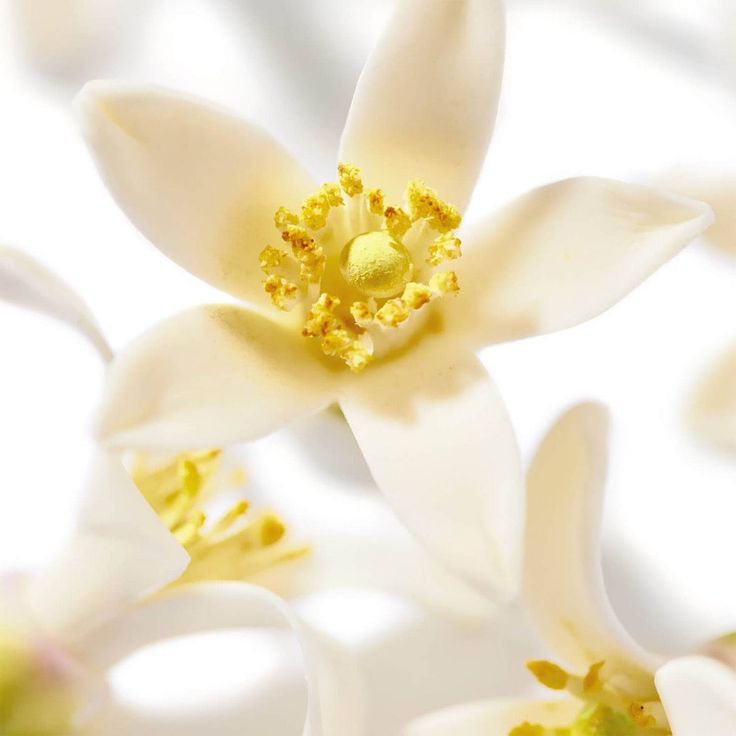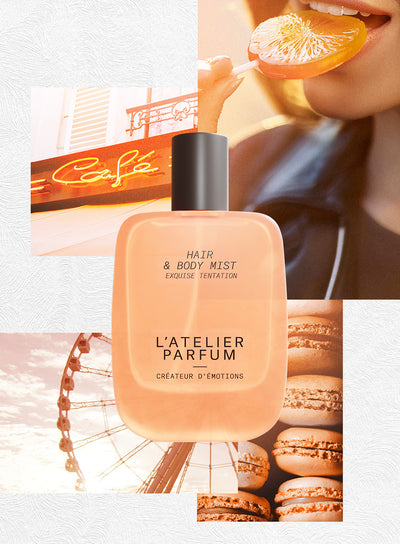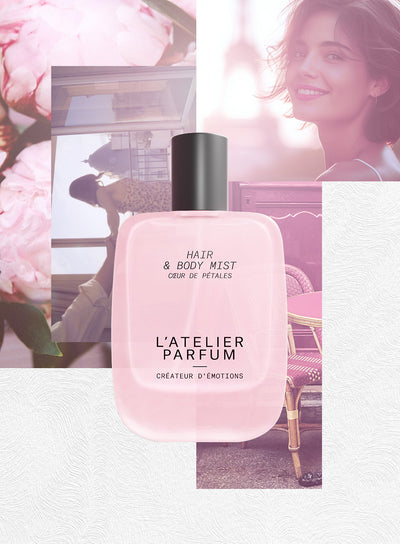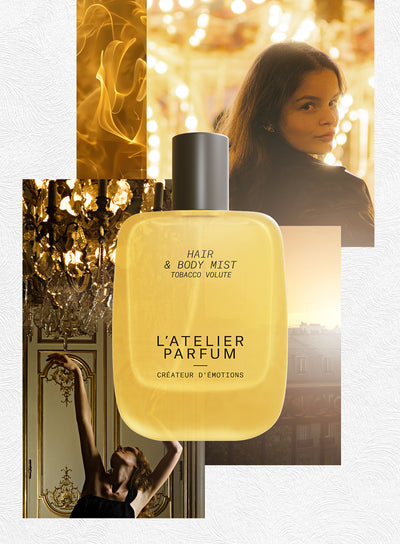- Ingrédients, Néroli
- L'Atelier Parfum
Neroli: The Essence of Elegance and Freshness

Ingredient Overview
Neroli is an essential oil obtained through steam distillation of the flowers of the bitter orange tree (Citrus aurantium). It differs from orange blossom absolute by its fresher, greener, and more sparkling character, with subtly spicy floral nuances. Its scent evokes a sense of cleanliness and radiance, often associated with colognes and refined, elegant compositions.
History and Origins
The name “neroli” comes from Anne-Marie Orsini, Princess of Nerola (Italy), who in the 17th century used this essence to scent her gloves and baths. Since then, neroli essential oil has become a symbol of luxury and sophistication in Europe. Orange blossom has been cherished since antiquity for its soothing properties and delicate fragrance.
Cultivation: From Flower to Essence
Neroli is extracted from the bitter orange tree (Citrus aurantium amara), a citrus originally from East Asia and now cultivated in some of the world’s most prestigious perfume regions.
Main Producing Regions
In Tunisia, the Nabeul region plays a key role in orange blossom cultivation. Since 1999, Robertet has worked with four local suppliers, including two long-standing partners. Most production comes from small-scale, family-run farms that ensure outstanding quality.
Growing Conditions
Harvest & Extraction
The flowers are handpicked in spring, between March and April — their fragility requires great care. Distillation is performed immediately via hydrodistillation to preserve the full richness and complexity of the fragrance. This process also yields a prized co-product: floral water, widely used in cosmetics.
It takes approximately one ton of flowers to produce one kilo of essential oil — making neroli a truly precious and luxurious ingredient.
Social and Economic Impact in Tunisia
The neroli distillation campaign boosts the local economy in the Nabeul region:
A network of flower pickers (often local farmers) harvests the blossoms and sells them to middlemen, creating a commission-based income system.
The harvest revives traditional expertise, including the use of the still, a handcrafted alembic used for extracting essential oils.
Nearly 3,000 families rely directly on this seasonal activity, which lasts about three to four weeks.
The production of “zhar” (orange blossom water) also plays a key role in local trade, particularly in the manufacture of exported perfumes.
Robertet has even acquired land to better control the traceability and quality of its supply.
Environmental Actions
In a commitment to sustainability, distillation residues are reused as natural fertilizers for future crops — closing the production loop while respecting local ecosystems.
Neroli in Perfumery
Neroli is beloved for its radiant and refreshing personality. It is frequently used in:
Neroli can take on many personalities:
Popular Fragrance Pairings
Did you know?
Beyond perfumery, neroli essential oil is prized for its therapeutic benefits:
Famous Perfumes Featuring Neroli
Neroli Portofino – Tom Ford
Aqua Allegoria Nerolia Vetiver – Guerlain
Neroli Sauvage – Creed
4711 Original Eau de Cologne – Mäurer & Wirtz
Eau de Toilette - Bonpoint
Arme Blanche - L'Atelier Parfum
Sundazed - Byredo
Sources :
Olfastory : Neroli in perfumery
Fragrantica : Neroli Ingredients
Neroli is an essential oil obtained through steam distillation of the flowers of the bitter orange tree (Citrus aurantium). It differs from orange blossom absolute by its fresher, greener, and more sparkling character, with subtly spicy floral nuances. Its scent evokes a sense of cleanliness and radiance, often associated with colognes and refined, elegant compositions.
History and Origins
The name “neroli” comes from Anne-Marie Orsini, Princess of Nerola (Italy), who in the 17th century used this essence to scent her gloves and baths. Since then, neroli essential oil has become a symbol of luxury and sophistication in Europe. Orange blossom has been cherished since antiquity for its soothing properties and delicate fragrance.
Cultivation: From Flower to Essence
Neroli is extracted from the bitter orange tree (Citrus aurantium amara), a citrus originally from East Asia and now cultivated in some of the world’s most prestigious perfume regions.
Main Producing Regions
- Morocco – One of the world’s leading producers, known for its pure and luminous neroli.
- Tunisia & Egypt – Mediterranean climates yielding high-quality floral essences.
- Italy & France (Grasse region) – At the heart of European perfumery tradition.
In Tunisia, the Nabeul region plays a key role in orange blossom cultivation. Since 1999, Robertet has worked with four local suppliers, including two long-standing partners. Most production comes from small-scale, family-run farms that ensure outstanding quality.
Growing Conditions
- Mediterranean climate: Mild winters and hot summers.
- Full sun exposure: Enhances essential oil concentration.
- Well-drained soil: Prevents root rot and supports healthy growth.
Harvest & Extraction
The flowers are handpicked in spring, between March and April — their fragility requires great care. Distillation is performed immediately via hydrodistillation to preserve the full richness and complexity of the fragrance. This process also yields a prized co-product: floral water, widely used in cosmetics.
It takes approximately one ton of flowers to produce one kilo of essential oil — making neroli a truly precious and luxurious ingredient.
Social and Economic Impact in Tunisia
The neroli distillation campaign boosts the local economy in the Nabeul region:
A network of flower pickers (often local farmers) harvests the blossoms and sells them to middlemen, creating a commission-based income system.
The harvest revives traditional expertise, including the use of the still, a handcrafted alembic used for extracting essential oils.
Nearly 3,000 families rely directly on this seasonal activity, which lasts about three to four weeks.
The production of “zhar” (orange blossom water) also plays a key role in local trade, particularly in the manufacture of exported perfumes.
Robertet has even acquired land to better control the traceability and quality of its supply.
Environmental Actions
In a commitment to sustainability, distillation residues are reused as natural fertilizers for future crops — closing the production loop while respecting local ecosystems.
Neroli in Perfumery
Neroli is beloved for its radiant and refreshing personality. It is frequently used in:
- Colognes, where it adds a bright floral-citrus note.
- Floral fragrances, paired with jasmine, rose, or lavender.
- Oriental and amber perfumes, to balance warm, sweet notes with freshness.
- Solar scents, evoking summer holidays, sun cream, and Mediterranean gardens.
Neroli can take on many personalities:
- Fresh and citrusy, when paired with lemon or bergamot.
- Floral and elegant, with white flowers like tuberose or ylang-ylang.
- Soft and comforting, when blended with musky or powdery notes.
Popular Fragrance Pairings
- With Citrus Notes (Bergamot, Lemon, Petitgrain) – For a fresh burst.
- With White Flowers (Jasmine, Tuberose, Orange Blossom) – For a refined floral bouquet.
- With Woody Notes (Sandalwood, Cedar, Vetiver) – For depth and elegance.
- With Green & Spicy Accords (Cardamom, Basil, Neroli Leaf) – For a vibrant, aromatic twist.
- With Gourmand Accords (Vanilla, Tonka Bean, Honey) – For a warm, enveloping feel.
Did you know?
Beyond perfumery, neroli essential oil is prized for its therapeutic benefits:
- Soothing & Anti-Stress: Used in aromatherapy to promote relaxation and emotional balance.
- Healing & Antioxidant Properties: Known for its skin-regenerating effects.
- Symbol of Purity & Love: Traditionally used in bridal bouquets and wedding perfumes.
L'Atelier Parfum creations with Neroli:
Famous Perfumes Featuring Neroli
Neroli Portofino – Tom Ford
Aqua Allegoria Nerolia Vetiver – Guerlain
Neroli Sauvage – Creed
4711 Original Eau de Cologne – Mäurer & Wirtz
Eau de Toilette - Bonpoint
Arme Blanche - L'Atelier Parfum
Sundazed - Byredo
Sources :
Olfastory : Neroli in perfumery
Fragrantica : Neroli Ingredients





